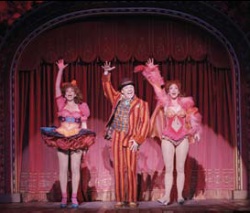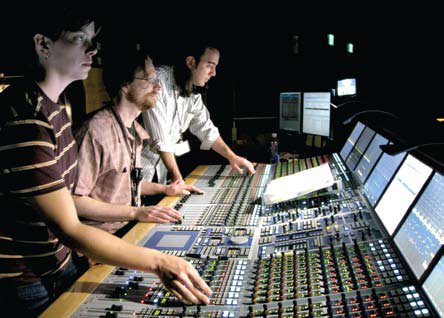
Moving Digital
Sound mixer Patrick Pummill, a 20-plus year veteran of musical theatre work, had not been exposed to the Stagetec platform prior to this show.
Up to this point, he’s primarily worked with analog consoles, and has tended to favor the Cadac models that have long proven their worth in live productions.
Faced with this unfamiliar format heading into Follies, he did some homework to get comfortable with the Aurus surface.
“It’s only been recently that I’ve started desiring more overall control on a scene-by-scene basis, which is the primary advantage of digital systems,” Pummill
notes. “This opportunity to use the Stagetec system has completely changed my outlook. Simply, it’s an extraordinarily powerful and configurable console that sounds fantastic.
“Sonically, it’s invisible,” he continues. “You get the system programmed, and when the show is up and running, the Aurus is a joy to mix on.”
This outlook is echoed by Harada, who notes that “part of the reason I prefer this system is that it’s transparent and responds very quickly, and the mic pres sound absolutely wonderful.”

“One of the other great features of the Aurus is that, as a designer, I can be very hands-on with the desk,” he adds. “The Aurus provides the capability to have many channel strips available outside of the central section. I can be making changes on channels on one end, and Jana (Hoglund, his associate) can be handling other channels on the other end of the console, all while Patrick is mixing. It feels like an analog console in that regard, and I find it a far more efficient system than other digital desks.”
True To The Source
The additional system components for Follies were loaded in on a Monday and up and running by the end of that day, and then were fully integrated with the house system on Tuesday.
Harada notes this ease of setup is another positive factor of the Stagetec system, as well as the skill of the technical crew of the Kennedy Center. He adds that the hands-on support of both the German and U.S. offices of Stagetec has been another big plus.
Pummill’s approach to mixing Follies is perhaps most accurately summarized with “first, do no harm.” The overall mantra is a true-to-the-source presentation.
“We’ve got a great orchestra and a bunch of great voices, so we really try to stay out of their way – we do not want to be reinterpreting their performances,” Pummill concludes. “Every voice is different – quiet, loud, different pitches, so it’s vital to be aware of each of those unique signatures.
“Particularly when it gets quieter, we want the added nuance that drives that compelling story being told on stage. A lot of it is feel with respect to levels. The idea is to draw the audience into the moment.”
Keith Clark is editor in chief of ProSoundWeb and Live Sound International.
